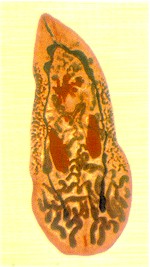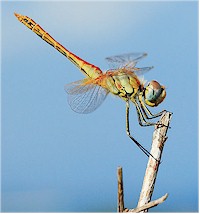Prosthogonimus (also called oviduct flukes) is a genus of flatworm parasites belonging to the trematodes that has chicken, ducks, turkey and other domestic and wild birds as final hosts. It is found worldwide in poultry kept outdoors with access to humid environments (swamps, marshes, wetlands, etc.) with abundant snails.
is a genus of flatworm parasites belonging to the trematodes that has chicken, ducks, turkey and other domestic and wild birds as final hosts. It is found worldwide in poultry kept outdoors with access to humid environments (swamps, marshes, wetlands, etc.) with abundant snails.
In regions with temperate climate infections are seasonal, mainly during spring and summer.
The main species of veterinary importance are:
- Prosthogonimus anatinus; affects mainly aquatic gallinaceous birds.
- Prosthogonimus macrorchis; affects chicken, turkey, ducks, goose, and other domestic as well as wild gallinaceous and songbirds (passerines).
- Prosthogonimus ovatus; affects gallinaceous and songbirds (passerines).
- Prosthogonimus pellucidus = cuneatus; affects chicken, turkey, duck, goose, and other domestic as well as wild gallinaceous birds.
The disease caused by Prosthogonimus flukes is called prosthogonimiasis.
Prosthogonimus spp does not affect dogs, cats, swine, herbivores (cattle, sheep, goats, horses, etc.) or any other mammals.
Are animals infected with Prosthogonimus flukes contagious for humans?
- NO. If chicken, turkey, ducks, etc. are infected with Prosthogonimus flukes, they are not contagious for humans, neither through contact, nor after meat or egg consumption, nor through the feces. The reason is that Prosthogonimus flukes do not parasitize humans and other mammals.
You can find additional information in this site on the general biology of parasitic worms and/or flukes.
Final location of Prosthogonimus spp
Predilection site of Prosthogonimus anatinus, Prosthogonimus macrorchis and Prosthogonimus ovatus is the oviduct. Predilection sites of Prosthogonimus cuneatus are the oviduct and the bursa of Fabricius, a special organ of birds where blood cells are produced.
Anatomy of Prosthogonimus spp
Adult Prosthogonimus have a flattened body characteristic for most flukes. They have a pear-like shape and reach 6-12 mm in length and 2-7 mm in width. The body is translucent and the cuticle has spines. They also have two suckers, the abdominal one being larger than the oral one. As other flukes, they have no external signs of segmentation.
The mouth ends in the pharynx, a muscular tube that allows sucking. The digestive system is blind (i.e. without exit: the only opening is the mouth) and not linear, as in most animals, but branched, ending in several blind ducts (called coeca). As most flukes, rumen flukes are simultaneous hermaphrodites, i.e. they have both male and female reproductive organs.
The eggs are rather small (~15x25 micrometers) and oval, one end with an operculum and the other end with a small spine.
Life cycle and biology of Prosthogonimus spp
Prosthogonimus has a complex indirect life cycle with two intermediate hosts, a freshwater snail (e.g. Bithynia) as the first intermediate host, and dragonflies as second intermediate hosts.

The fluke eggs shed in the feces of a final host continue development only after getting into an aquatic environment. They tend to fall to the bottom and are eaten by aquatic snails. Inside the snails' intestine they develop to miracidia that penetrate the intestine's wall and develop to sporocysts. Sporocysts multiply asexually to daughter sporocysts and to the next larval stage, the cercariae.
Mature cercariae and leave the snail through its feces and can swim. In the water, cercariae find a dragonfly larva (= naiad) and penetrate into its body through the anus. They encyst in the muscles of the abdominal wall and form metacercariae. About two months later these metacercariae become infective for birds. Metacercariae survive the metamorphosis of the naiad to adult dragonflies.
Chicken, ducks, goose and other birds become infected eating both contaminated dragonflies, either naiads or adult. Inside the birds gut the metacercariae release the young flukes, which migrate to the bursa of Fabricius and later on to the oviduct through the cloaca (also called the vent), where they complete development to mature flukes and start producing eggs.
The prepatent period in the birds takes one to several weeks, depending on the fluke and the bird species.
Harm caused by Prosthogonimus spp, symptoms and diagnosis
Prosthogonimus is usually more harmful for chicken and turkey than for ducks and geese. It is not an issue in industrial indoor operations, but can be very harmful in free ranging birds with acces to humid environments. A few flukes do not cause clinical signs. But severe infections can be very harmful for the hens and substantially impair egg laying: oft eggs, eggs with no shells at all, or even amorphous masses full of flukes. Most harm is caused by the flukes' cuticular spines that damage the birds' oviduct tissues and disturb its peristaltic motility. The inflammation can spread to the whole abdomen and cause peritonitis. Secondary infections with bacteria are not unusual and can significantly worsen the situation.
Typical symptoms include lime discharge from the cloaca that may contain flukes, and subsequent soiling of the feathers around the vent. Heavily affected birds lose appetite and refuse feeding, become listless and thirsty, walk abnormally, show difficult breathing and have a tense and hot abdomen. If this stage is reached fatalities can be abundant.
Diagnosis can be confirmed through eggs found in the cloacal discharge. Adult flukes can be detected in the oviducts, cloaca or bursa of Fabricius after necropsy of sick or dead birds.
Prevention and control of Prosthogonimus spp
A key preventative measure for free ranging operations in endemic regions is to eliminate the humid environments where naiads can develop. If this is not possible, the birds must be kept away from such environments with adequate fencing, at least 50 meters away from water, to reduce the risk that the birds feed also on adult dragonflies. Another recommended measure is to keep the birds indoors in the cool morning hours or after heavy rains or storms, when the dragonflies tend to remain still on the vegetation and are an easy prey for the birds. Birds with suspected symptoms must be culled and inspected for adult flukes in the affected organs.
In most countries there are very few or no commercial anthelmintics at all with an approved claim against Prosthogonimus flukes of poultry. There are reports that praziquantel (5 to 10 mg/kg) and mebendazole (10 to 50 mg/kg) may be effective. Other broad-spectrum benzimidazoles (e.g. albendazole, fenbendazole) may show some efficacy.
Many other classic flukicides do not control Prosthogonimus flukes, e.g. clorsulon, nitroxinil and triclabendazole. Neither macrocyclic lactones (e.g. ivermectin) nor levamisole are effective against any kind of flukes either.
Chemical control of the snails with molluscicides (i.e. snail killers) such as copper sulphate, sodium pentachlorophenate, niclosamide, etc. is never an option for controlling Alaria flukes in the environment. It would never be economic and is anyway hopeless and useless, because it is virtually impossible to treat every place where they can survive, and they reproduce extremely quickly. In addition, the use of such molluscicides is not approved in most countries. For similar reasons, trying to control the naiads or the dragonflies with larvicides and/or insecticides is not at all recommended: it would be extremely harmful for the environment.
There are so far no vaccines against Prosthogonimus flukes. To learn more about vaccines against parasites of livestock and pets click here.
Biological control of Prosthogonimus flukes (i.e. using their natural enemies) is so far not feasible.
You may be interested in an article in this site on medicinal plants against external and internal parasites.
|
Ask your veterinary doctor! If available, follow more specific national or regional recommendations for Prosthogonimus control. |
Resistance of Prosthogonimus spp to anthelmintics
So far there are no reports on resistance of Prosthogonimus flukes to anthelmintics.
This means that if an anthelmintic fails to achieve the expected efficacy, chance is very high that either the product was unsuited for the control of Prosthogonimus flukes, or it was used incorrectly.